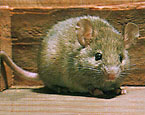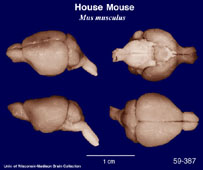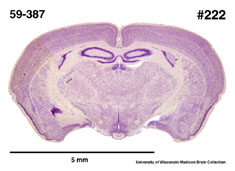|
House
Mouse
(Mus musculus) #59-387 |
||||
|
|
Physical
characteristics and distribution
|
|
Mus musculus is the House Mouse. This mouse is believed to be the second most populous mammalian species on Earth, after Homo sapiens. They are light brown to black, with short hair and a light belly. The ears and tail have little hair. Adults weigh some 12 to 40 grams; their body (including tail) is about 15-19 centimeters long, with the tail usually accounting for a bit more than half of it. They live in a wide variety of hidden places that are near food sources and construct nests from various soft materials. Mice are territorial and one dominant male usually lives together with several females and young. If two or more males are held together in a cage, they will often turn aggressive unless they have been raised together from birth. House Mice primarily feed on plant matter, but they will also accept meat and dairy products. They will drink water but require little of it, relying mainly on the moisture present in their food. They will eat their feces to acquire nutrients produced by bacteria in their guts. The gestation period is about 19-21 days, and they give birth to a litter of 3-14 young (average 6-8). One female can have some 5-10 litters per year, so their population can increase very quickly. Breeding occurs throughout the year (however, animals living in the wild don't reproduce in the colder months, even though they don't hibernate). The newborn are blind and furless. Fur starts to grow some three days after birth and the eyes open one to two weeks after birth. Females reach sexual maturity at about 6 weeks and males at about 8 weeks, but both can breed as early as 35 days. House Mice are spread over the world's continents and islands (except Antarctica) through its close association with humans (see details: Mammals Species of the World, Vol 2, 2005, p1398). |
|
Description
of the brain
|
|
Animal
source and preparation
|
|
All
specimens collected followed the same preparation
and histological procedure.
|
Other Related Resources (websites and publications)



